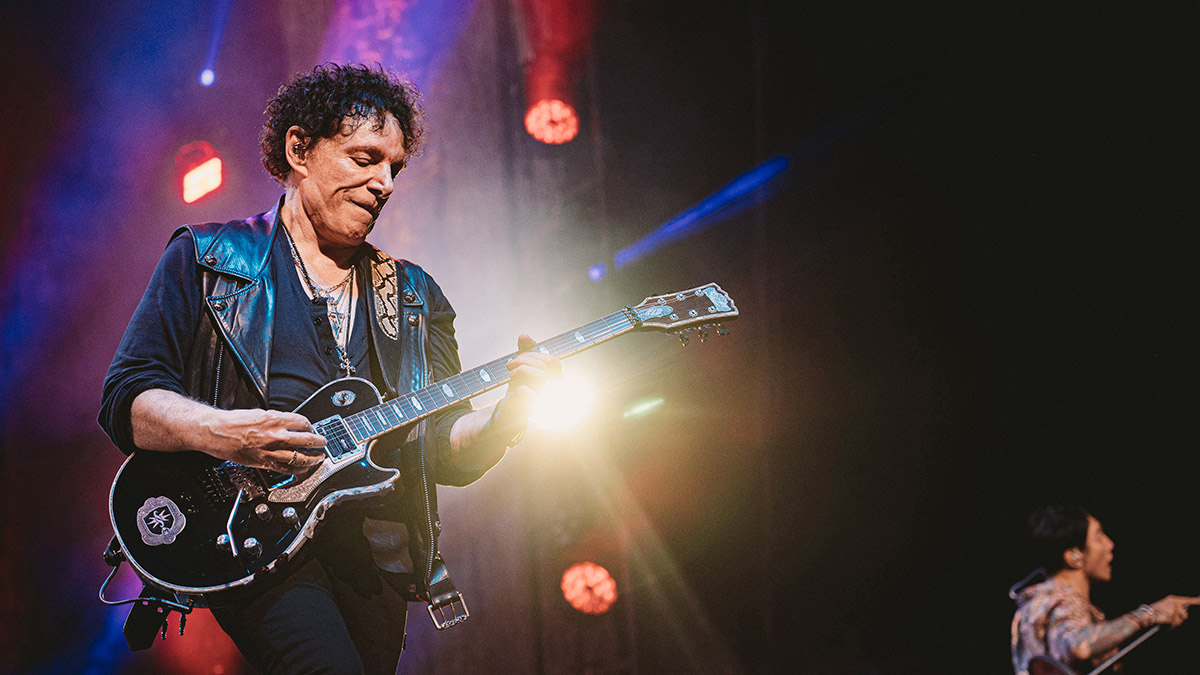With an anthemic, ultra-melodic approach, Neal Schon helped define the sound of ‘80s rock – upgrade your chops with a deep-dive into the Journey virtuoso’s legendary rhythm and lead styles
Don't stop believin', but do start practicing on this video and tab lesson that unpacks Schon's tuneful, radio-friendly approach to rhythm and lead guitar

Journey were formed in 1973 in San Francisco, California, by ex-Santana guitarist Neal Schon, now the only original member left in the lineup. The band’s most successful period was in the 1980s, where Schon featured alongside singer Steve Perry, bassist Ross Valory, keyboard player Jonathan Cain, and drummer Steve Smith.
This era saw the release of legendary songs such as Don’t Stop Believin’, Any Way You Want It, and Open Arms.
Journey in many ways epitomize the sound of rock from the 1980s, and this era saw them blend guitar riffs with what was then modern synth sounds, big choruses, and shredding solos. During this time they toured as a headline act with support coming from artists such as Bryan Adams, and headlined festivals with special guests Van Halen and other massive acts.
Schon also found time to work with keyboard legend Jan Hammer, and Paul Rodgers, as well as forming the side project band Bad English, which featured John Waite on lead vocals.
There have been numerous legal battles between band members over the years, which include some in very recent times, but they did manage to release a new album in 2022 called Freedom, with Arnel Pineda on vocals and Randy Jackson playing bass.
Neal Schon joined Carlos Santana’s band as a 17-year-old, apparently turning down Eric Clapton’s offer of joining Derek and the Dominos. His guitar playing style inevitably draws influence from Santana, as well as many of the blues greats, such as B.B. King and Clapton.
Schon also played as a session musician in the 1980s for artists like Michael Bolton, and his blues- and jazz-influenced playing spearheaded much of the rock style heard on records of that era, when fantastic guitar players like Schon himself, Dann Huff, Steve Lukather, and Michael Landau were regularly heard playing on the pop radio hits of the artists of the day.
The track this month is very much focused on the sound of Journey from the 1980s and has a chord-based riff in the key of G Major (G-A-B-C-D-E-F#). It doesn’t at any point stray outside of this key and the main parts are built on a I-V-VI-IV chord progression of G Major, D Major, E Minor 7, and C Major.
The second section of the rhythm track has a C Major chord and a D Major chord, each played over a C bass note. This gives us the sound of the C Lydian mode (C-D-E-F#-G-A-B) when the D Major chord (D-F#-A) appears over the C bass note – the F# in the chord is the #4th interval, which gives us the sound of the Lydian mode.
The solo is mostly melodic, but with some fast flurries of notes that might catch you out if you’re not prepared. It’s one of the main features of Schon’s lead playing style.
Get the tone
Amp Settings: Gain 8, Bass 6, Middle 7, Treble 7, Reverb 4
It’s classic 1980s rock to aim for this month, so any Marshall amp style sound with a good amount of preamp gain will work well. Add some chorus, delay and reverb to taste. Schon tends to favor humbucking guitars such as Gibson Les Pauls, PRS models or Super Strat-style guitars by the likes of Tom Anderson. Select the bridge pickup and you’re good to go.
Example 1. Rhythm
There are a lot of chords accented loudly in the track. The main G, D, Em7 and C chords are played strong and loud, with the eighth-note chords in bars 9-16 accenting the changes.
There are also lightly palm-muted notes in between the chord changes. The low C note in bars 17-24 is also palm muted, which again allows for the other notes to be accented loudly. While this may sound rather complex, it should prove intuitive once you start playing the example.
Example 2. Lead
This solo has a good blend of melody and technique, with the fast phrase in bars 37-38 accenting the first note of each sextuplet. There is a mix of alternate picking and legato in this phrase: try out the picking suggestions below the tab, otherwise swap them around to start with a down pick.
Get The Pick Newsletter
All the latest guitar news, interviews, lessons, reviews, deals and more, direct to your inbox!
"Upgrading from your entry-level acoustic opens the door to an entirely new world of tonewoods, body shapes, and brands": 6 signs it's time to upgrade from your first acoustic guitar
"I'm past my prime": 5 common excuses for not learning the guitar – and 5 body and mind-boosting reasons you should









![Joe Bonamassa [left] wears a deep blue suit and polka-dotted shirt and plays his green refin Strat; the late Irish blues legend Rory Gallagher [right] screams and inflicts some punishment on his heavily worn number one Stratocaster.](https://cdn.mos.cms.futurecdn.net/cw28h7UBcTVfTLs7p7eiLe.jpg)


